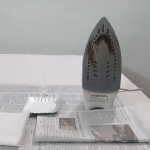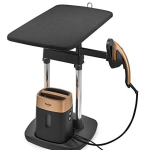Have you ever noticed your iron unexpectedly dripping water while you are trying to make your clothes look nice and neat? It can be annoying. This article is here to help you understand why this happens and what you can do about it. We will look at how heat and water work together in irons, causing those unexpected drips. We will also talk about why the kind of water you use matters and how to stop these drips from happening. So, let’s dive in and find out Why an Irons leaks water while ironing and How to Fix a Leaking Iron.
The Anatomy of an Iron: How Does Steam Iron Works
In This Article
Let’s get to know your iron better. It’s not just a handy tool; it’s a mix of parts that work together. Imagine the soleplate touching your clothes and the holes where the steam comes out. These parts join forces to make your clothes smooth.
From where the steam comes from. The water tank in your iron is important. It holds water that becomes steam. To remove wrinkles, steam works similarly to the iron’s assistant by applying heat and a small amount of moisture. However, this modification might occasionally result in issues like drips and leaks while you’re ironing.
Sometimes, the seals and valves that let the water flow can have trouble. When they don’t work well, water might drip out where you don’t want it.
Major Reasons for Irons Leakage and Preventions:
As we journey deeper into the realm of iron care, we’re entering the domain of reasons and prevention, where the battle against leaks truly takes shape. Let’s explore how the type of water you use, keeping the water level in check, regular cleaning routines, descaling techniques, and proper storage practices can contribute to a leak-free ironing experience.

1. Hard vs. Soft Water: Impact on Iron Performance
The type of water you choose to fill your iron with holds more power than you might think. Imagine hard water, heavy with minerals like tiny saboteurs. They stealthily linger after the water evaporates, forming stubborn residues that clog the delicate pathways within your iron. These sneaky deposits are troublemakers, causing steam to flow unevenly and even opening the door to possible leaks. But soft water is good for your iron’s parts. It has no heavy minerals so, preventing the buildup and ensuring everything works smoothly. So, in the long term, distilled water (soft water) is good for our iron as it does not affect the wall and soleplate holes.
2. The Wrong Water Level: Keep the Balance
Believe it or not, the water level in your iron matters. Too much or too little water can lead to a variety of issues, including leaks. It’s crucial to follow your iron’s instructions and strike the right balance. Overfilling might cause water to escape through steam vents, while too little water can result in inadequate steam production, affecting ironing efficiency.
3. Cleaning the Soleplate Holes and Water Tank
Just like any tool, irons require consistent care. Cleaning your iron’s soleplate constantly after a certain period according to usage can help prevent mineral buildup, ensuring optimal steam distribution and reducing the likelihood of leaks. A simple mixture of water and vinegar can work wonders in keeping your iron in tip-top condition.
4. Descaling
Limescale, a stubborn residue left behind by hard water, can be a major contributor to leaks. Descaling is the art of removing these deposits. From using commercial descaling solutions to natural alternatives like citric acid, exploring the best descaling method for your iron can significantly extend its life while curbing leaks. We recommend to buy a latest steam irons which are having anti-calcium function.
5. Storage Matters: Preventing Leaks When Irons Are Not in Use
Even during downtime, your iron needs care. Emptying the water reservoir after use prevents stagnant water from turning into corrosive steam, which can damage seals and result in leaks. Storing your iron in an upright position allows any residual water to evaporate harmlessly, further safeguarding against leaks.
6. Right Temperature Setting:
Heat the iron before starting ironing and keep the balance temperature. Set the thermostat properly. As iron may leak water if the temperature is kept too low because iron needs enough heat to turn the water into steam before pressing clothes.
The science behind Steam and Temperature
Let’s peek into the magic of how steam and temperature team up in your iron. This part of our journey reveals the cool science that makes ironing work so well, and also occasionally leads to those pesky leaks.
When water gets super-hot, its molecules start moving really fast and jumping around. Eventually, they get so excited that they break free from each other and become steam, which is a kind of invisible gas. This process is called “evaporation.” So, when you see steam coming out of your iron or a pot of boiling water, you’re seeing water molecules that are so excited, they’re dancing their way into the air as steam!
Imagine steam as a gentle helper for your clothes. When your iron sends out steam onto wrinkled fabric, it’s like giving your clothes a warm and moist hug. This moisture makes the fabric fibers loosen up, letting the wrinkles fade away. The steam and heat mixture are making your clothes look super smooth.
Conclusion: Why an Iron Leaks Water
Finally, by understanding the ironing mastery you can understand the reason behind water leakage and how to fix and take care of steam iron. By developing an insight into how steam, temperature, and water work in a balanced way. Further, with proper care, cleaning your iron after some time, using high water quality, and a hands-on approach to maintenance, you know how to ensure a future of smooth and wrinkle-free clothes without any damage or stain because of iron.
At last we recommend you to buy the latest steam irons and steamers having anti-calcium function. As, these irons have cartages that carry the lime scale deposits and you can change them with time to prevent any effect on your iron or steamer.











